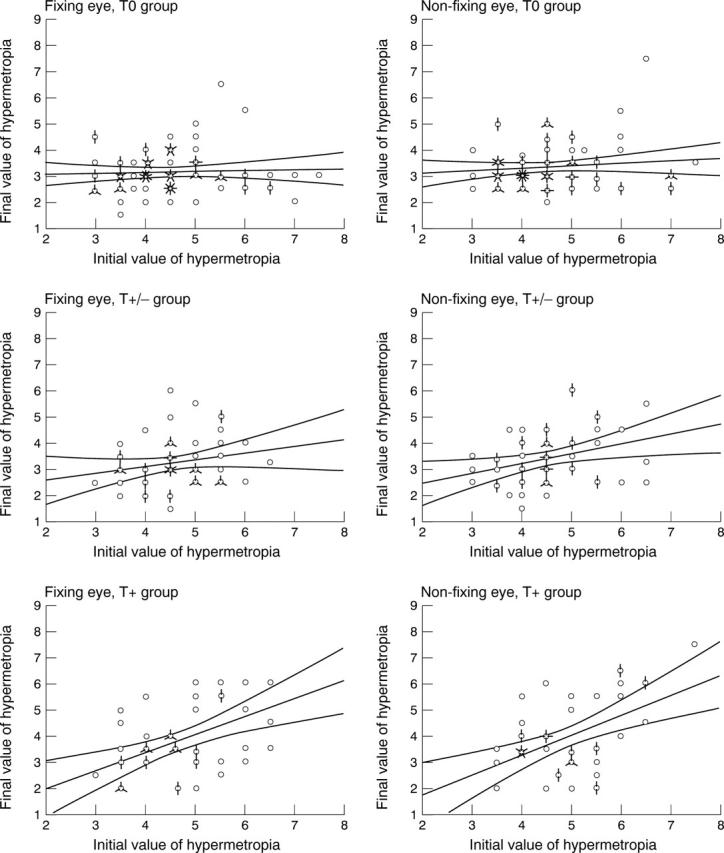Abstract
AIM—To explore why emmetropisation fails in children who have strabismus. METHODS—289 hypermetropic infants were randomly allocated spectacles and followed. Changes in spherical hypermetropia were compared in those who had strabismus and those who did not. The effect of wearing glasses on these changes was assessed using t tests and regression analysis. RESULTS—Mean spherical hypermetropia decreased in both eyes of "normal" children (p<0.001). The consistent wearing of glasses impeded this process in both eyes (p<0.007). In the children with strabismus, there were no significant changes in either eye, irrespective of treatment (p>0.05). CONCLUSIONS—In contrast with normal infants, neither eye of those who had strabismus emmetropised, irrespective of whether the incoming vision was clear or blurred. It is suggested that these eyes did not "recognise" the signal of blurred vision, and that they remained long sighted because they were destined to squint. Hence, the children did not squint because they were long sighted, and glasses did not prevent them squinting.
Full Text
The Full Text of this article is available as a PDF (106.2 KB).
Figure 1 .

Effect of spectacles on changes in spherical hypermetropia of normal children (linear regression with 95% confidence intervals).
Selected References
These references are in PubMed. This may not be the complete list of references from this article.
- ABRAHAM S. V. Accommodation in the amblyopic eye. Am J Ophthalmol. 1961 Aug;52:197–200. doi: 10.1016/0002-9394(61)91115-1. [DOI] [PubMed] [Google Scholar]
- Abrahamsson M., Fabian G., Sjöstrand J. Refraction changes in children developing convergent or divergent strabismus. Br J Ophthalmol. 1992 Dec;76(12):723–727. doi: 10.1136/bjo.76.12.723. [DOI] [PMC free article] [PubMed] [Google Scholar]
- Atkinson J., Braddick O., Robier B., Anker S., Ehrlich D., King J., Watson P., Moore A. Two infant vision screening programmes: prediction and prevention of strabismus and amblyopia from photo- and videorefractive screening. Eye (Lond) 1996;10(Pt 2):189–198. doi: 10.1038/eye.1996.46. [DOI] [PubMed] [Google Scholar]
- Aurell E., Norrsell K. A longitudinal study of children with a family history of strabismus: factors determining the incidence of strabismus. Br J Ophthalmol. 1990 Oct;74(10):589–594. doi: 10.1136/bjo.74.10.589. [DOI] [PMC free article] [PubMed] [Google Scholar]
- Brown N. P., Koretz J. F., Bron A. J. The development and maintenance of emmetropia. Eye (Lond) 1999;13(Pt 1):83–92. doi: 10.1038/eye.1999.16. [DOI] [PubMed] [Google Scholar]
- Cumming B. G., Judge S. J. Disparity-induced and blur-induced convergence eye movement and accommodation in the monkey. J Neurophysiol. 1986 May;55(5):896–914. doi: 10.1152/jn.1986.55.5.896. [DOI] [PubMed] [Google Scholar]
- Ehrlich D. L., Braddick O. J., Atkinson J., Anker S., Weeks F., Hartley T., Wade J., Rudenski A. Infant emmetropization: longitudinal changes in refraction components from nine to twenty months of age. Optom Vis Sci. 1997 Oct;74(10):822–843. doi: 10.1097/00006324-199710000-00022. [DOI] [PubMed] [Google Scholar]
- FINCHAM E. F., WALTON J. The reciprocal actions of accommodation and convergence. J Physiol. 1957 Aug 6;137(3):488–508. doi: 10.1113/jphysiol.1957.sp005829. [DOI] [PMC free article] [PubMed] [Google Scholar]
- Hokoda S. C., Ciuffreda K. J. Measurement of accommodative amplitude in amblyopia. Ophthalmic Physiol Opt. 1982;2(3):205–212. [PubMed] [Google Scholar]
- Hung L. F., Crawford M. L., Smith E. L. Spectacle lenses alter eye growth and the refractive status of young monkeys. Nat Med. 1995 Aug;1(8):761–765. doi: 10.1038/nm0895-761. [DOI] [PubMed] [Google Scholar]
- Ingram R. M., Arnold P. E., Dally S., Lucas J. Emmetropisation, squint, and reduced visual acuity after treatment. Br J Ophthalmol. 1991 Jul;75(7):414–416. doi: 10.1136/bjo.75.7.414. [DOI] [PMC free article] [PubMed] [Google Scholar]
- Ingram R. M., Arnold P. E., Dally S., Lucas J. Results of a randomised trial of treating abnormal hypermetropia from the age of 6 months. Br J Ophthalmol. 1990 Mar;74(3):158–159. doi: 10.1136/bjo.74.3.158. [DOI] [PMC free article] [PubMed] [Google Scholar]
- Ingram R. M., Gill L. E., Goldacre M. J. Emmetropisation and accommodation in hypermetropic children before they show signs of squint--a preliminary analysis. Bull Soc Belge Ophtalmol. 1994;253:41–56. [PubMed] [Google Scholar]
- Kiorpes L., Boothe R. G. Accommodative range in amblyopic monkeys (Macaca nemestrina). Vision Res. 1984;24(12):1829–1834. doi: 10.1016/0042-6989(84)90014-2. [DOI] [PubMed] [Google Scholar]
- Nathan J., Kiely P. M., Crewther S. G., Crewther D. P. Disease-associated visual image degradation and spherical refractive errors in children. Am J Optom Physiol Opt. 1985 Oct;62(10):680–688. doi: 10.1097/00006324-198510000-00003. [DOI] [PubMed] [Google Scholar]
- Owens D. A., Mohindra I., Held R. The effectiveness of a retinoscope beam as an accommodative stimulus. Invest Ophthalmol Vis Sci. 1980 Aug;19(8):942–949. [PubMed] [Google Scholar]
- Semmlow J. L., Bérard P. V., Vercher J. L., Putteman A., Gauthier G. M. The interactive processes of accommodation and vergence. Bull Soc Belge Ophtalmol. 1994;253:135–146. [PubMed] [Google Scholar]
- Sherman A. Some recent clinical observations and training procedures in functionally amblyopic patients. J Am Optom Assoc. 1970 Jul;41(7):624–626. [PubMed] [Google Scholar]
- Troilo D. Neonatal eye growth and emmetropisation--a literature review. Eye (Lond) 1992;6(Pt 2):154–160. doi: 10.1038/eye.1992.31. [DOI] [PubMed] [Google Scholar]
- URIST M. J. Primary and secondary deviation in comitant squint. Am J Ophthalmol. 1959 Nov;48:647–656. doi: 10.1016/0002-9394(59)90456-8. [DOI] [PubMed] [Google Scholar]
- Wood I. C., Tomlinson A. The accommodative response in amblyopia. Am J Optom Physiol Opt. 1975 Apr;52(4):243–247. doi: 10.1097/00006324-197504000-00001. [DOI] [PubMed] [Google Scholar]
- von Noorden G. K., Avilla C. W. Accommodative convergence in hypermetropia. Am J Ophthalmol. 1990 Sep 15;110(3):287–292. doi: 10.1016/s0002-9394(14)76346-9. [DOI] [PubMed] [Google Scholar]


